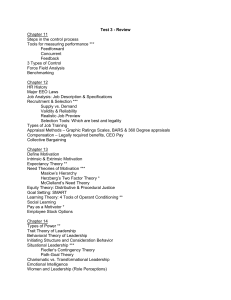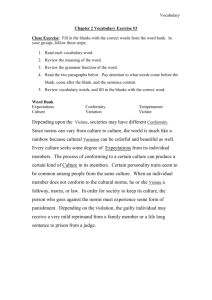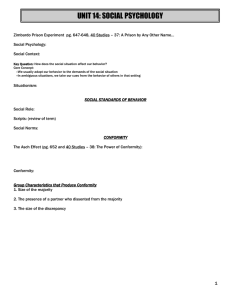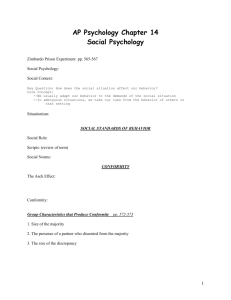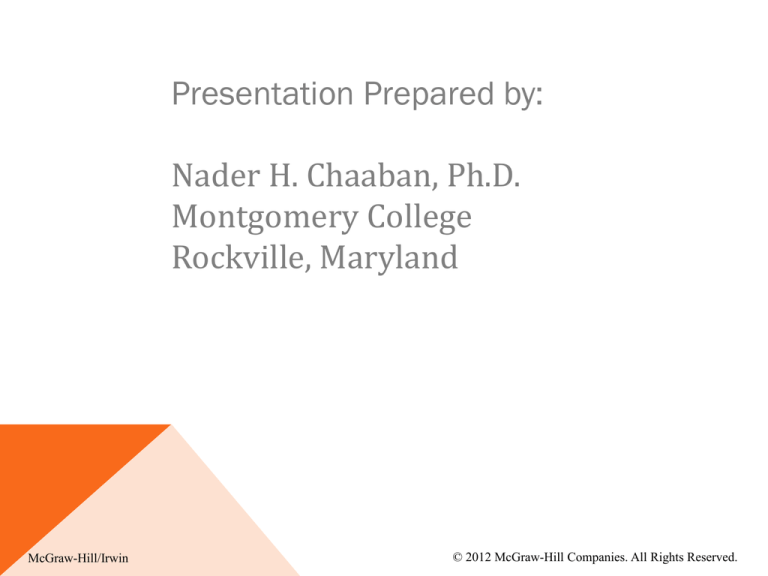
Presentation Prepared by:
Nader H. Chaaban, Ph.D.
Montgomery College
Rockville, Maryland
McGraw-Hill/Irwin
© 2012 McGraw-Hill Companies. All Rights Reserved.
5-2
Leadership and Social Influence Processes
•
•
•
•
•
Status and Power
Leadership
Followership
Contingency Theory
Group Norms: Social Influence and
Conformity
• Group Development
5-3
Status and Power
• Types of Status
– Status is defined as a person’s position or
rank relative to others in a group.
– Differences in status in a group may either
facilitate or hinder interaction.
5-4
STATUS AND POWER
• Types of Status
– Power and status equal the ratio of the
number of successful power acts to the
number of attempts to influence.
– The success rate and relative status of any
individual will vary from group to group.
5-5
STATUS AND POWER
• Types of Power
–
–
–
–
–
Reward power
Coercive power
Legitimate power
Referent power
Expert power
5-6
STATUS AND POWER
• Power tends to equate to effectiveness in the
eyes of others.
– Comments in small groups tend to be directed
more often (by direction of eye contact) to
higher-status group members than to those of
lower status.
• Positive and Negative Uses of Power
– Most experts agree that power tactics are amoral.
5-7
LEADERSHIP
• An effective leader is essential for optimal group
performance.
• Historic Trends
– Trait Theory
• The physical traits associated with
leadership were height, weight, physical
attractiveness, and body shape.
– Circumstances Theory
• A person may be an effective leader in one
circumstance but perform poorly in a
different circumstance.
5-8
LEADERSHIP
• Historic Trends
– Function Theory
• Leadership consists of certain behaviors, or
functions, that groups must have
performed.
– 1. Task orientation
– 2. People orientation
– 3. Change-oriented behaviors (Yukl et al,
2002)
5-9
LEADERSHIP
– Interaction Process Analysis. Categories of
Communicative Acts
5-10
LEADERSHIP
• Leadership Styles
– Early studies identified three different styles:
• Autocratic
• Democratic
• Laissez-faire
5-11
LEADERSHIP
• SuperLeaders
– A SuperLeader who gets a lot of other people
involved is said to develop SuperTeams.
– Manz and Neck (1999) have proposed the
idea of self-leadership:
• We are each responsible for our own
choices.
• The challenge is to channel these choices
in a desirable direction.
5-12
FOLLOWERSHIP
• Followership Styles
– Dependent
– Counterdependent
– Independent
5-13
FOLLOWERSHIP
• Leadership and Followership Styles
5-14
FOLLOWERSHIP
• Research has revealed that followers contribute
80% to the success of the organization, while the
leader only contributes a mere 20%.
• Followers should be valued and held
accountable for the successes of any group while
their leaders should be rewarded for encouraging
the followers to reach their full potential.
5-15
CONTINGENCY THEORY
• Fiedler and Chemers (1974) and Potter
and Fiedler (1993) argue that a
combination of three separate factors
determines a leader’s effectiveness:
– Leader-member relations
– Task structure
– Position power
5-16
• Fiedler’s Contingency Leadership Model
5-17
• Hershey and Blanchard’s Contingency
Model of Leadership
5-18
GROUP NORMS: SOCIAL INFLUENCE AND
CONFORMITY
• Wood, Phillips, and Pedersen (1986) define
norms as “standardized patterns of belief,
attitude, communication and behavior within
groups.”
5-19
GROUP NORMS: SOCIAL INFLUENCE AND
CONFORMITY
• Guidelines for helping groups arrive at
more creative solutions (Leonard and
Swaps, 1999).
– Avoid changing your mind only to avoid
conflict and to reach agreement and harmony.
– Withstand pressures to yield, which have on
objective or logically sound foundation.
– View differences of opinion as both natural
and helpful.
5-20
GROUP NORMS: SOCIAL INFLUENCE AND
CONFORMITY
• Conformity: Research and Applications
– Conformity is when most members of the
group agree on a particular outcome and
minority influence is when the decision made
reflects the opinion of the minority.
– In group situations, the social influence of the
majority often causes the opposing minority
members to change their views to that of the
majority, even if the majority is clearly
wrong.
5-21
GROUP NORMS: SOCIAL INFLUENCE AND
CONFORMITY
• Conformity: Research and Applications
– Groupthink represents a form of social
influence of the majority that results in a
dangerous level of agreement by all members
of the group, even if the decided action is
obviously wrong.
– To prevent Groupthink, alternative
viewpoints should be fostered by the leader
instead of hidden.
5-22
GROUP NORMS: SOCIAL INFLUENCE AND
CONFORMITY
5-23
Group Norms: Social Influence and
Conformity
Theoretical Curves of Communications from
Strong Rejectors, Mild Rejectors, and Four
Nonrejectors to the Deviant in the Four
Experimental Conditions.
5-24
GROUP DEVELOPMENT
• Group development seems to occur in four
phases.
– Phase 1 (orientation)
• Group members break the ice and begin to
find out enough about one another to have
some common basis for functioning.
– Phase 2 (conflict)
• Frequently characterized by conflict of one
kind or another.
5-25
GROUP DEVELOPMENT
• Group development . . . (continued)
– Phase 3 (emergence)
• Involves a resolution of the conflict
experienced in Phase 2.
– Phase 4 (reinforcement)
• The phase of maximum productivity and
consensus.
5-26
Review of the Systems Approach
• High-status individuals tend to have more
power.
• The leadership style that would be appropriate in
one situation with one set of followers may not
be the most appropriate in a different situation
with a different set of followers.
5-27
The Systems Approach
• Conformity pressure differs depending on
the type of group, the personalities of the
group members, and a number of other
factors.
• Groups go through fairly common phases,
depending on the type of group.
5-28
THE END
5-29

